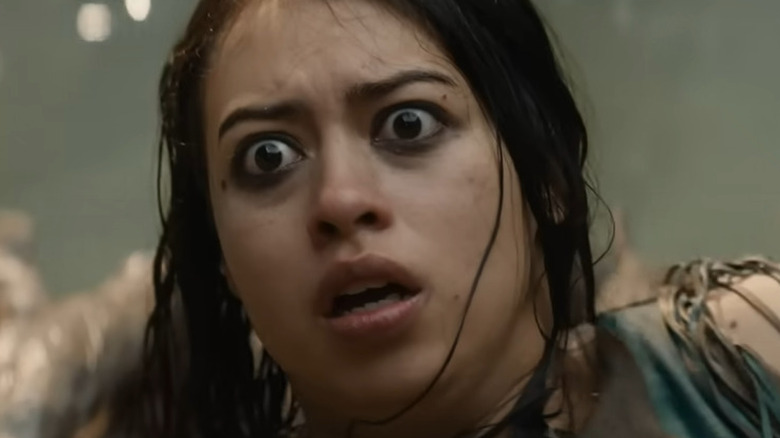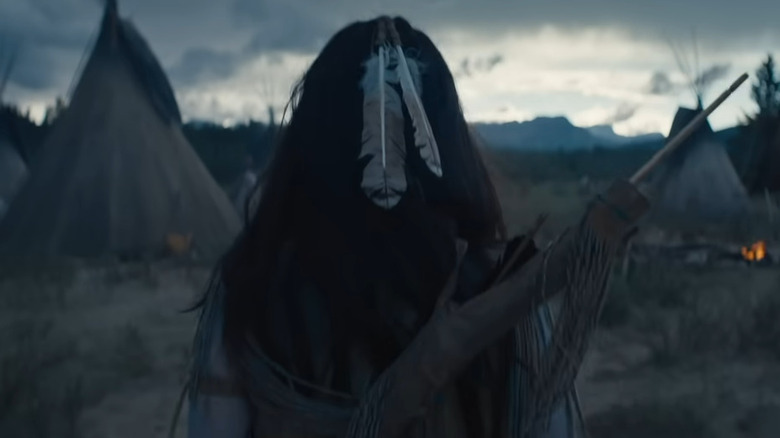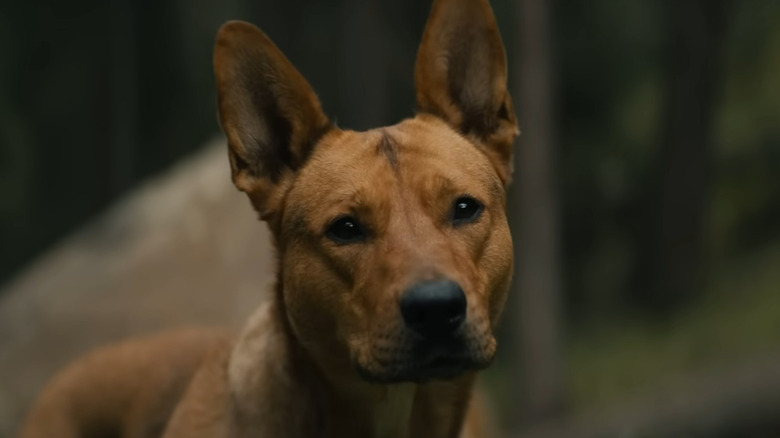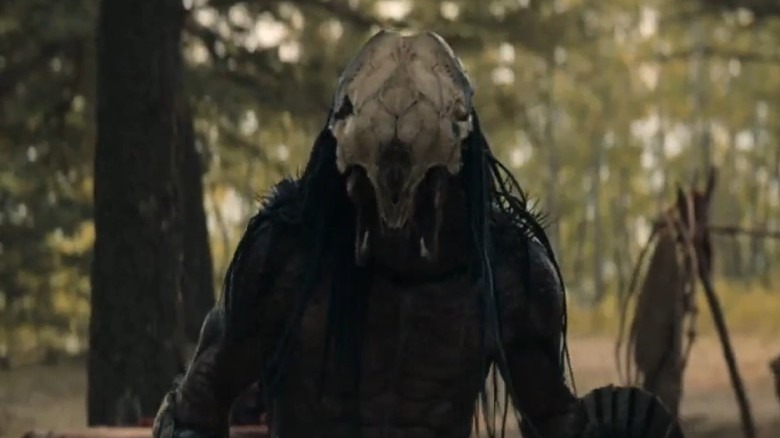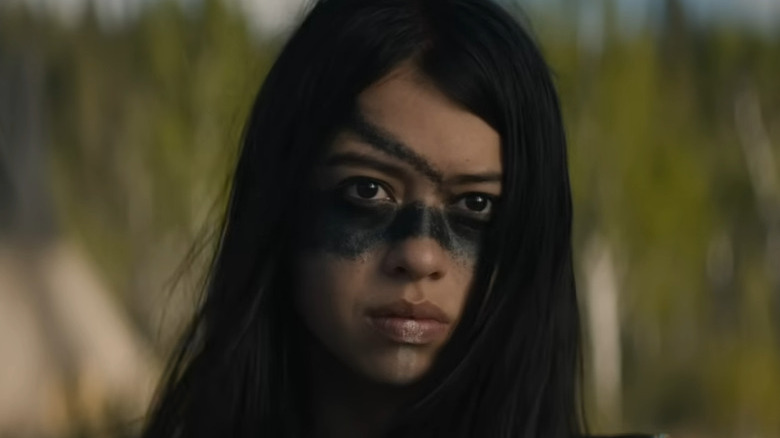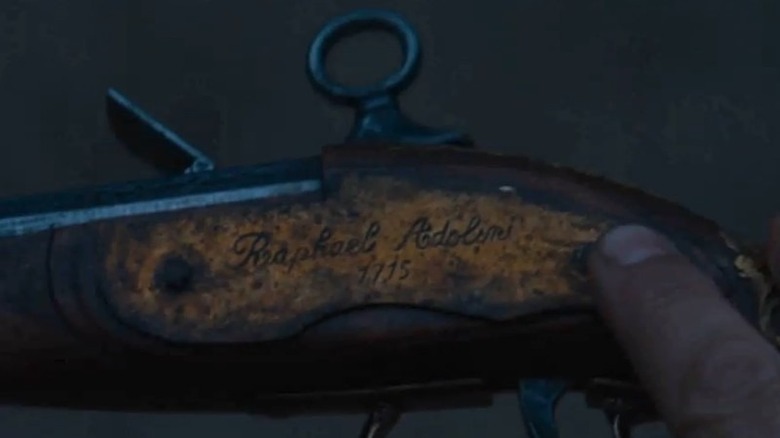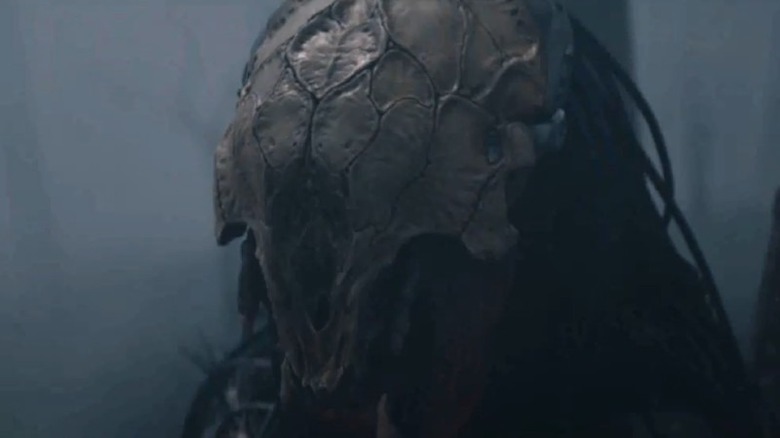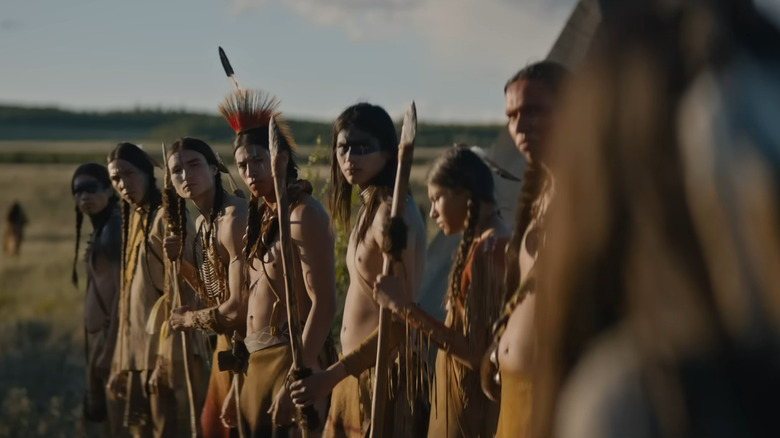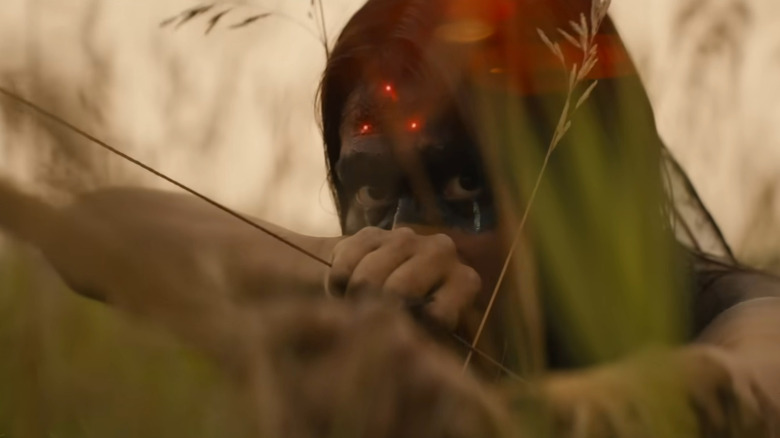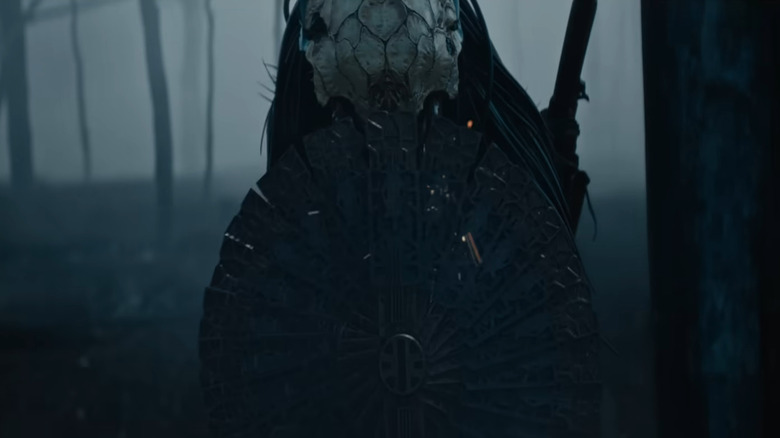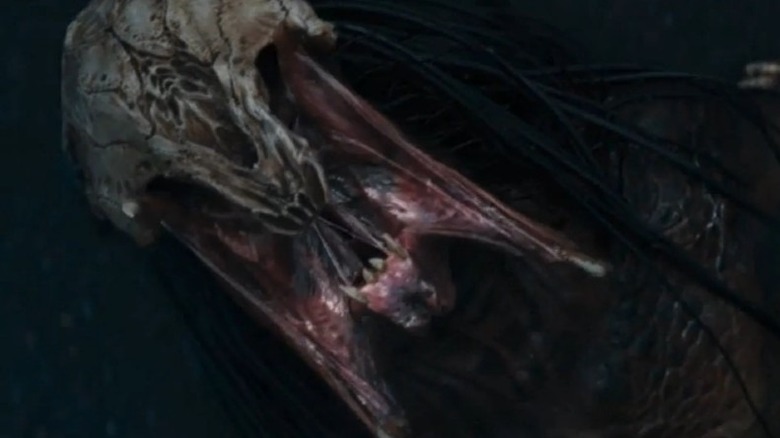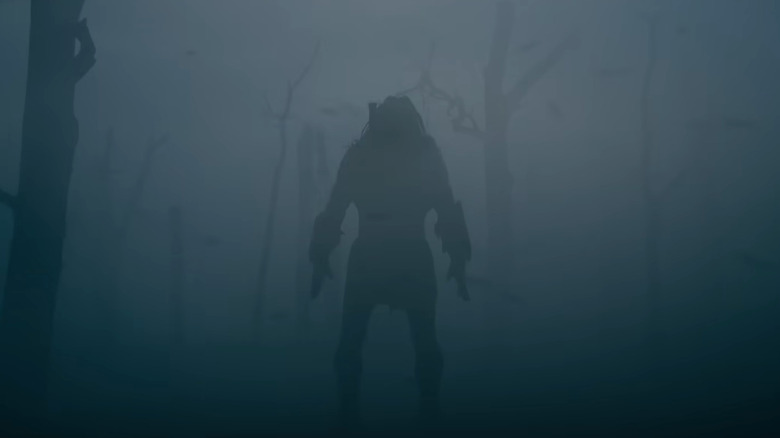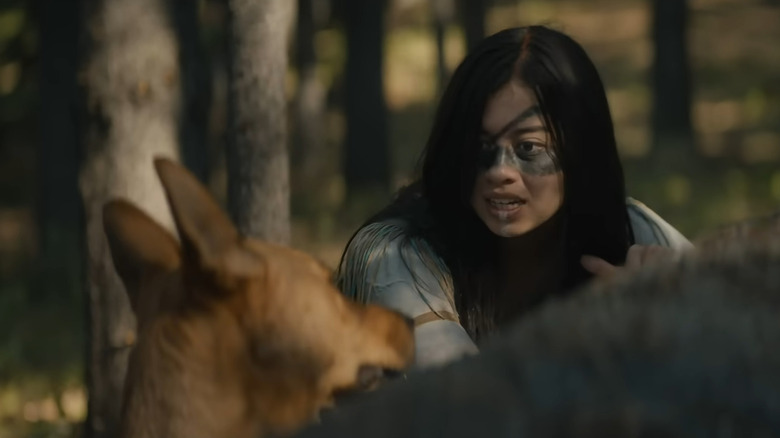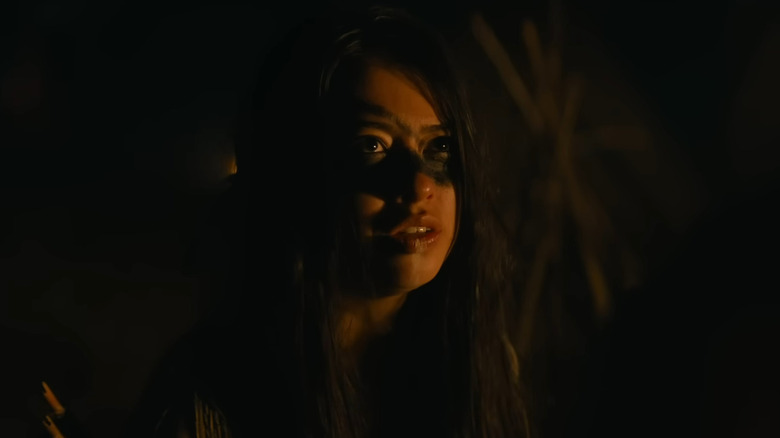Biggest Unanswered Questions In Prey
The "Predator" film series receives both a sequel and a prequel with "Prey," a film that pits the alien hunter against a Comanche tribe in the early 18th century. Specifically, the Yautja invader battles against Naru (Amber Midthunder), a young woman desperate to prove herself and her capability as a warrior to her friends and family. Along the way, the film adds some interesting details to the "Predator" lore, while also posing a number of curious questions.
Despite the franchise having existed for decades, much remains mysterious about the Yautja, their warrior customs, their societal structure, and their obsession with hunting other species. That's largely because many of the stories that have fleshed out those parts of the world — like the various comics and the "Alien vs. Predator" movies — are of dubious canonical status at best. For some, especially critics, that's hardly a problem. After all, mystery and enigma are part of what makes the idea of a giant invisible alien enemy so exciting on the big screen. And yet, it's hard after so many core films and spinoff stories not to wonder how all the pieces fit together.
"Prey" provides a few answers through its historical setting, but it also creates some new questions, leaving the franchise as a whole about as mysterious as it found it. Here are some of the biggest unanswered questions in "Prey," possible theories, and what they could mean for the future of the series.
What happens to the Predator's ship?
The particular Yautja who arrives on Earth in "Prey" has a ship that's shown a handful of times — mostly while it's transitioning in and out of active camouflage. It's even visible as early as the first scene, where a slight disturbance in the sky over Naru's village foreshadows the alien's arrival. But what happens to the ship after the Predator descends to the ground?
In the shot where the Predator is properly deployed, he simply drops from his ship, which re-enters camouflage and disappears into a nearby mass of clouds. Is the ship on autopilot? Are there other Yautja onboard, setting off for other spots on Earth or even other planets? What happens to it after Naru kills the Predator? While these questions might all seem minor in the grand scope of the story, their answers would provide some interesting insight. It's unknown just how extensively the Yautja have explored Earth and humanity by 1719, and getting a look inside the ship would definitely give some clues. Perhaps for the best, though, "Prey" is more interested in the action on the ground, leaving the many mysteries of the Yautja's ship unanswered.
Why is the Predator so interested in animals?
Though the Yautja are most famous for battling the best warriors humanity has to offer, the Predator in "Prey" spends a good deal of time fighting other kinds of animals. Bears, snakes, and wolves are all on the list of the alien's, well, prey, and a couple of those creatures even manage to get some hits in before inevitably falling.
But why is the Predator so interested in fighting these other animals? There are a couple of potential explanations. "Prey" could be one of the first (if not the first) instances of a Predator actually journeying to Earth. If that's the case, it would make sense for the alien to want to test its mettle against a variety of species to determine which is the strongest on the planet. A few shots throughout show the Predator scanning different animals, including humans, but it's unclear if this is to create a record of species or if it's simply using a preexisting database to identify animals. Either way, one thing seems clear — this particular Yautja is on Earth for trophies, and it doesn't especially care what kind of skulls it goes home with.
How old is the Predator in Prey?
Another possible explanation for the Predator's interest in hunting regular animals in "Prey" is that it's a younger Yautja rather than one of the older, established hunters seen in the other "Predator" films. While this certainly isn't confirmed, there is precedent in the franchise for ritual and coming-of-age traditions in the Yautja culture, as evidenced by the hierarchy and elders seen at the end of "Predator 2." Additionally, there are a lot of hints throughout "Prey" that the alien facing off against Naru is also trying to prove itself to its tribe.
Fighting any strong animal that comes its way; slaughtering a whole battalion of soldiers in cocky style; falling victim to its own sophisticated laser-guidance system — these are all signs that the Predator in "Prey" might not be all that experienced in the ways of the hunt. Of course, that theory would probably mean that previous Yautja had explored Earth before, as a young and unproven warrior likely wouldn't be trusted with the first deployment. This creature is also notably smaller than the biggest ones seen in the "Predator" movies, which is another clue that it could be relatively young.
Not only would this theory make a good amount of narrative sense, but it would also align with the overarching themes of the film. Naru is trying to prove herself worthy by hunting a dangerous creature, and it would be almost poetic if the Predator she faces is actually doing the same.
Why doesn't Naru take the Predator's gear?
Naru successfully uses the Predator's own helmet-mounted lock-on system to kill it, but when she returns to her tribe all she carries of the creature is its severed head. What of the deployable shield, the active camouflage, the armor, the weapons, and all the other pieces of advanced technology? Was it damaged beyond use in the fight? Is it impossible for humans of the early 18th century to decipher? Or does Naru simply believe that she and her people are better off without such strange tools?
That last option might be the most likely. "Prey" makes a point of showing how advanced technology can be an untrustworthy ally, such as when the flintlock pistol given to Naru fails to fire, and when the Predator is killed by its own weapon. Ultimately, instincts, intelligence, and survival skills are shown to be far superior to any piece of sci-fi tech, which might be why Naru lets the Predator's gear rot in the mud. Or maybe, with the influx of European invaders, she'd simply rather leave the tools out of potentially dangerous and treacherous hands.
What's the deal with the flintlock pistol?
At the end of "Predator 2," Danny Glover's Lt. Mike Harrigan character is given a gift by an elder Predator — a flintlock pistol from the year 1715 — as a sign of respect. According to the name engraved on the gun, it once belonged to a Raphael Adolini. While this moment is mainly meant to emphasize just how long the Yautja have hunted on Earth, the pistol has become a key piece of "Predator" lore.
At the end of "Prey," it's revealed that the flintlock pistol given to Naru midway through the movie is the same one seen in "Predator 2." The character who gives her the gun is credited in the film as "Raphael," which would seem to tie the whole thing up nicely. Or it would, if not for a few lingering questions.
The big mystery about the pistol now is how it got back into the hands of the Yautja at all. Unless they specifically tracked it — which seems unlikely — it would be random chance for them to encounter whoever it got passed down to decades or centuries later. The most logical explanation might be a pretty dark one: The Predators return for Naru later on, defeat her, and take the gun as a trophy. Whatever the explanation, the return of the flintlock pistol is a pretty notable retcon of previously established "Predator" lore.
How long have the Predators been on Earth?
Depending on what "Predator" stories you're reading or watching, you might have one of several different understandings of the Yautja's history on Earth. The "Alien vs. Predator" movies show a timeline where the species lived among humans thousands of years in the past, and the comics show Predators hunting humans as early as 1718. That might sound like it would line up perfectly with the events of "Prey," but the fifth film in the franchise actually retcons some of the previous lore pretty severely in terms of how long the Yautja have been around.
The comic book "Predator: 1718" tells the story of Raphael Adolini, a pirate captain who encounters a Predator shortly before his death. In the comic, he gives his engraved flintlock pistol to the Yautja as a sign of respect — the gun that's given back to humanity at the end of "Predator 2." But in "Prey," that flintlock pistol is given to Naru by a member of the European party. That would seem to undo the entire "1718" story from any kind of canon, which means that the actual history of Predators on Earth is once again pretty murky.
"A long time ago, it is said, a monster came here," Naru says in the film's first line of narration — a line that's never given proper context. Is she speaking before the events of "Prey," or after? Perhaps Predators have come to her home before, but it's never confirmed.
Is this the first Predator killed by humans?
Whether or not the Predator in "Prey" is the first of its kind to hunt on Earth, it's possible that it's the first Yautja to actually fall in battle to a human. To be fair, that's nothing to be ashamed of. It takes nearly all of the hunters in Naru's tribe to take the alien down, with her only able to deliver the finishing blow after learning from each friend and family member it kills. The Predator in "Prey" also seems more than a little cocky and overconfident in its own strength, which ultimately contributes to its demise.
Whether or not this is actually the first Predator killed by a human is impossible to know — at least at this time. But given the body count that the Yautja racks up in "Prey," it seems unlikely that anyone from a prior, less advanced era would have stood a chance against one of the aliens.
Why doesn't the Predator have a plasma cannon?
There are some pretty big differences between the Predator in "Prey" and the ones seen in the other films in the franchise. Primarily, though the Yautja still has a lot of impressive technology (active camouflage, laser-guided weapons, an invisible spaceship, etc.), it's not nearly to the level seen in later human hunts. This is most visible in one particularly glaring absence — the shoulder-mounted plasma cannon that's typically been the Yautja's most iconic and dangerous weapon.
In prior films, the plasma cannon is connected to the triangular targeting laser used by the Predators to hunt down their targets. In "Prey," however, that targeting apparatus is connected to a handheld spear gun — still a deadly weapon, as is proven multiple times, but not quite as advanced as the plasma cannon. The simplest explanation for the classic weapon's absence is that Predator technology just isn't quite as advanced in "Prey," which would make sense given that it's several hundred years removed from the rest of the series. The Predator also has a mechanical shield, rather than an energy-based one, and a much simpler helmet and suit of armor than those worn by later Yautja.
Even still, it seems odd that a race that's achieved invisibility and interstellar travel hasn't yet mastered the science of big, silly laser guns. Another possible explanation is that the Yautja in "Prey" just chooses to use simpler tools in an effort to make the hunt more challenging.
How advanced is the Predator society during Prey?
The lack of classic Predator tools in "Prey," like the plasma cannon and the traditionally augmented Yautja helmet, leads to other questions about the alien society as a whole. Because most of the creature's familiar weapons are still in the film, and because the Yautja clearly still have mastery of interstellar travel in 1719, it would seem that there aren't that many differences from the culture glimpsed in previous films. After all, what're a few hundred years to a species that's already out traveling amongst the stars?
Because "Prey" takes a more ground-level approach to the series' lore and the overarching "Predator" story, it's not especially interested in the ins and outs of Yautja society, which is probably for the best. Even still, it's hard not to wonder how expansive the Predators' galactic hunting pattern is during the time of the film. Are there others on Earth hiding in plain sight? Was the Predator in "Prey" truly the best they had to offer?
What's the mask that the Predator wears?
Historically, Predators wear full helmets that hide their mandibulated alien faces. In "Prey," however, the Yautja that fights Naru sports a very different piece of headgear. More of a mask than a helmet, it looks like it could be part of a skull — possibly a trophy from a past hunt modified with a laser-tracking system. What creature the trophy was taken from and why the Predator chooses to wear the mask, however, remain unknown.
At the very least, the mask suggests that this isn't the Predator's first rodeo. The hunter has clearly killed before, but not necessarily on Earth. With a spaceship at the ready, the mask could belong to any number of as-yet-unnamed species across the galaxy.
It's also unclear if using this kind of trophy mask instead of the more traditional helmet is the norm of the time or a personal choice. We don't get to see another Predator in "Prey," but it's possible that the Yautja choosing the mask instead of the classic armor is some kind of prideful display.
Where will the Predators hunt next?
Dropping a Predator so far in the past and pitting it against the hunting prowess of the Comanche Nation is a great setup for a movie, and it begs the question of where else the Yautja might land on Earth to hunt going forward. It's easy to imagine future installments in the franchise seeing Japanese samurai, Zulu warriors, or Celtic tribes facing off against their own extraterrestrial opponents, and there's certainly a lot of potential in that idea.
This seems especially sensible given the code that the Yautja live by, which dictates that it's best to hunt the strongest possible opponents (military commandos in the original "Predator" movie, for instance). It's possible that the Predator in "Prey" sought out the Comanche specifically because of their skill in battle, or it's possible that the alien simply happened upon the tribe after a time scouring the globe for worthy adversaries. Regardless, it would be fun to see Yautja of other eras test their strength against some of the other greatest fighters humanity has produced across time.
Will Naru continue to be a hunter?
All Naru wants for much of "Prey" is to be treated with respect and dignity as a hunter — to be accepted by her tribe for the thing she knows she's best at. And by the end, she seems to have accomplished that goal. When she deposits the decapitated head of the Predator at the feet of her tribe's elders, everyone begins to celebrate. She's recognized not only as a skilled hunter, but also as a protector of her people.
At least, that's what seems to happen. There's certainly celebration, and you'd think it would be impossible for the rest of the tribe not to see her as a master hunter after bringing down the Yautja. However, we don't actually get to see what happens after. Naru recommends that the tribe relocates to a safer place (more because of the Europeans than because of the risk of another alien invader), and it seems that the others will take her advice. But will she be able to hold onto that position of respect, or will time eventually whittle away all the progress she's made in stepping beyond the role assigned her?
There's also a possibility that Naru might not even want to hunt anymore. The experience of fighting the Predator was surely very traumatic, especially because of all her friends and family members killed during the battle. In all likelihood, Naru will only continue to get stronger, but her challenges are certainly far from over.
Will the Predators return for Naru?
When the "Prey" credits roll, it looks like Naru is finally on the other side of her toughest battle. The Predator is dead, and with it, one threat to her tribe. Though she loses a lot of people along the way, including her brother Taabe (Dakota Beavers), Naru ultimately triumphs, and she returns to her tribe covered in the glowing green blood of her fallen enemy. But what if the Yautja return to face her again?
There isn't much precedent in the "Predator" movies for the aliens targeting the same prey twice. In fact, "Predator 2" suggests that winning a duel with a Yautja might actually grant a kind of immunity, as Lt. Mike Harrigan is allowed to walk free with a gift from the Yautja at the end of that film. It's that exact gift, though, that suggests Naru may not have yet seen her final extraterrestrial encounter.
Because she now possesses the flintlock pistol — a weapon that falls into Predator hands by the 1990s — there's a chance that the Yautja return for Naru and take the gun after defeating her. Of course, given how well she fares in "Prey," that would be a tall task — even for another Predator.
